Household Pest Control
Information contained in this fact sheet will assist home and building owners in controlling infestations of pest insects plus a few other common home-invading arthropods. The important first step in the process of insect pest control is to identify the pests that are present so that proper management procedures will be used. OSU county Extension directors and state Extension specialists in Entomology, and pesticide sales dealers can help identify the pest for the homeowner, or the pest may be sent to the OSU Entomology Department for identification.
The homeowner can usually control light infestations of pests in the house by carefully
following directions on the pesticide container and by doing a thorough job of application.
Sanitation and good housekeeping are possibly the most important aspects in controlling
or preventing pests, but even well-kept homes sometimes become infested.
Certain pests found outside may be eliminated before they enter the home. For information
on control of pests outdoors, refer to Extension Fact Sheet EPP-7306. However, some
insects live entirely within the home, where they must be controlled by applying spray,
dust, bait, or aerosol pesticides to areas where they are most frequently found. If
the infestation is severe and widespread, it is advisable to employ the services of
a pest control company that has pesticides and application equipment not generally
available to homeowners. Additionally, an internet search for almost any pest will
provide useful information.
Equipment for Applying Pesticides
Following is a list of some of the more common types of pesticide application equipment available.
Small hand-held sprayers — Effective for applying space sprays in the home (to kill flies and mosquitoes). Not
effective for applying residual sprays. These sprayers usually have a 1- to 2-pint
(½ to 1 quart) capacity, and the spray is discharged as a fine mist.
Compressed-air sprayers — Effective all-purpose sprayers for home use if equipped with atomizers. These are suitable for applying liquid formulations to cracks and crevices, and around and behind baseboards for various pests found in and around the home.
Aerosol 'bombs' — Insecticide is contained under pressure in a metal cylinder, and when the valve is
opened the spray is released as a fine airborne mist. Aerosols are useful for applying
a fine mist back into cracks and crevices and for use as open space sprays.
Garden hose attachments — When sufficient water pressure is present, hose spray attachments are useful for
applying insecticides outside the home.
Dusters — Small, hand-held puff dusters are available for use inside homes, and many types
of dusters are available for applying insecticide dusts to control garden, ornamental,
and lawn insects.
Pesticide Formulations
When purchasing commercially formulated, ready-to-use (RTU) pesticides, select the one that is designed for the specific problem you are trying to solve. Some common pesticides that homeowners use may contain one of the following active ingredients: deltamethrin, permethrin, bifenthrin, cyfluthrin, lambda-cyhalothrin, carbaryl, or pyrethrin.
Alternatives to ready-to-use sprays are available in several different formulations:
oil solutions (OS), emulsifiable concentrates (EC; E), micro-encapsulated (MEC; M),
wettable powders (WP; W), soluble powders (SP), flowable liquids (FL), and dusts (D).
To avoid mistakes or misuse, all pesticide users should read the label thoroughly
before purchasing and using a pesticide. Certain formulation types are used most often:
Oil Solutions (OS) — Some household sprays are formulated as insecticide-in-oil solutions. When applying
and oil-based solution, care should be used because oily sprays may damage asphalt
tile and the rubberized backing on carpets. Also, oils may soften and discolor linoleum
and plastic materials. If in doubt about spraying such surfaces, first test the effects
of the insecticide formulation on a small, inconspicuous spot location and observe
its effects before deciding to treat a large area.
Emulsifiable Concentrate (EC or E), Flowable liquid (FL), or Micro-encapsulated (MEC). These formulations contain insecticide plus an emulsifier that allows the insecticide
concentrate to be mixed with water for use as a spray. Read the label completely because
most of these insecticide formulations are for use only outside the home or other
structure.
Wettable Powders (WP or W) — These powders contain concentrated insecticide, usually expressed in percentages,
that must be mixed with water before use. Sprays prepared from wettable powders require
frequent agitation to maintain a uniform mixture. Wettable powder sprays are generally
recommended for use outside the home.
Dusts (D) — Dusts are ready-to-use mixtures of toxicant incorporated with a dry “filler or carrier”
such as talc or fine powdered clay. Dust formulations may be used inside the home
but usually leave unsightly residues. They are often used in cracks and crevices,
behind baseboards, or behind electrical wall plates. Also, dust particles get into
the air when applying, so a respirator must be used.
Measurements and Conversion Factors
1 tablespoon = 1/2 (0.50) liquid ounce = 3 teaspoons
1 cup = 8 liquid ounces (0.50 pint) = 16 tablespoons
2 pints = 32 liquid ounces = 4 cups = 1 quart
Safety Tips
- Read and follow all directions on the pesticide container label.
- Avoid repeated or prolonged contact of insecticides with the skin and avoid inhalation of spray mist.
- Do not spray insecticide-oil solutions near an open flame (gas flame pilot lights).
- Do not risk contaminating food by treating near food, dishes, food preparation surfaces, or cooking and eating utensils.
- Triple-rinse, puncture, and properly dispose of empty pesticide containers, but do not puncture or incinerate aerosol or pressurized spray cans.
- Store insecticides in their original labeled containers, and in a dry place where they cannot contaminate food-stuffs or where children and pets do not have access to them.
- After using pesticides, always wash your hands and face and any other exposed body areas with soapy water.
- For further information on handling, mixing, and applying pesticides, consult your state extension entomologists, visit your local county Extension educator, and refer to Extension Fact Sheet EPP-7450 for more information on safe use of pesticides.
NOTE: See comments on contaminated water at the end of "Household Pest Control Suggestions" below.
Prevention and Control Hints
Before applying insecticides, the homeowner can ensure improved pest control by accomplishing the following procedures:
- Remove room and garage clutter, and clean out storage areas to eliminate harborages for pests.
- Clean up areas that collect grease, food scraps and debris, or other spillage that provides a food resource.
- Eliminate excess, non-used storage boxes from attics and garages, and remove waste grass cuttings and leaves, and dead foliage from around the outside foundation of the house that would otherwise create hiding places for all types of arthropods and other pest animals.
- If grain, flour, or corn starch beetle and moth pests are observed, locate the infested food and harborage areas. Inspect cereal boxes and flour containers, spillage on cupboard and pantry shelves, bags of beans, dry pet food, and spice containers until the infestation sources are located. Dispose of the infested food materials, and freeze remaining, non-infested flour, cereals, and other grain products. Sanitation and clean-up equals success in reducing or eliminating these types of pests. A limited application of pesticide can also be beneficial.
- Carefully inspect newly purchased dried foods for insect infestation, and store these foods in tightly sealed glass, plastic, or metal containers rather than in cloth or paper sacks, bags, or boxes. When possible, freezing newly purchased dry foods for a week before placing them in the cupboard can be useful.
NOTE: To date, ultrasonic, electronic, or sound-emitting devices have not been scientifically proven to be effective.
I. Pests of Food or Food Products
ANTS

(1/6-1/2")
Several species are found in the home, feeding on all kinds of food materials, including sweets, starches, and greasy fatty foods. Eliminate the food resources attracting ants into the home. Follow good sanitary practices, and give particular attention to drain boards, window sills, door thresholds, and cracks and crevices. Ant control in many instances is difficult, and a commercial pest control service may be required to eliminate the infestation.
For successful control and possible colony eradication, it is essential to locate and apply an ant-labeled pesticide to all entry locations where ants can invade a home or structure and where they are foraging for food. Additionally, baits are also effective when properly placed where ants are present. Using caulk and screening to exclude ants is effective. Sanitation, including removal of debris and wood piles from around structures removes nesting and hiding areas. Home-made bait of syrup mixed with boric acid powder (3 tsp. BA + 10 oz. syrup) in a small container may be effective (keep away from children and pets).
Insecticides (indoor). Combat® (hydramethylnon) or MaxForce® (fipronil) ant bait gel, or a contact insecticides like DeltaDust® (deltamethrin) or Ortho Home Defense® (bifenthrin) ready-to-use spray, and several additional liquid spray and dust formulations have been effective.
Insecticides (outdoor). Ant baits can provide some control. General household insecticides, and products such as boric-acid containing baits, and baits like Combat have been effective. Products containing pyrethroids such as cypermethrin, per methrin, lambda-cyhalothrin, and bifenthrin are effective as perimeter applications around buildings and as ant mound and nest drenches.
COCKROACHES
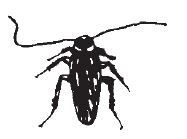
(1/4 - 1 ½")
Cockroaches exit their hiding places at night and feed on all types of food-stuffs as well as starchy materials such as book binding glues. During the day, roaches congregate in dark places such as inside kitchen cabinets and under sinks, behind plumbing fixtures, in closets, behind appliances and baseboards, and around bathroom fixtures. American and Oriental roaches often hide beneath buildings or in dark, damp, sheltered locations.
Cockroaches, like other insects, require adequate food, water, and shelter (harborage) to proliferate. Removing food resources, reducing water sources, and eliminating hiding areas are part of an effective control program. Good sanitation and garbage removal, keeping pet foods in sealed containers, and excluding them from structures by structural repairs, caulking and screening off entry points are important steps in control.
Insecticides (indoor). Ready-to-use sprays of several insecticides that contain permethrin and bifenthrin are available. Silica gel powder, or bait stations containing boric acid are labeled for roach control. Products containing hydroprene (Gentrol), or Combat IGR, or MaxForce®FC Roach Killer Bait Gel (fipronil) or MaxForce Pro Roach Killer Bait Gel (hydramethylnon) bait stations with insect growth regulator (IGR) are effective. DeltaDust, Suspend SC, and several additional dusts and sprays are widely marketed. Boric acid baits are also used. Roach sticky traps can help with control and aide in identifying areas with high concentrations of cockroaches.
NOTE: Use precautions to keep chemicals out of feed, food, spices and condiments, and off
of shelves, counter tops, dishes, and eating utensils.
PANTRY PESTS
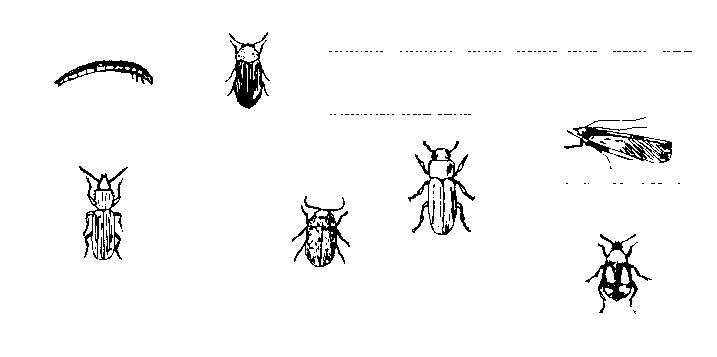
Mealworm: (3/4")
Saw-toothed grain beetle: (1/10")
Drug store beetles: (1/10")
Cigarette beetle: (1/10")
Bean weevil: (1/8")
Confused flour beetle: (1/7")
Indian meal moth: (3/4")
These insects feed on cereal, flour, corn starch, dry pet food, pepper and other spices, nuts, dried fruit, and grits, as well as other items found in the home such as dried flower arrangements and plant-based stuffing of furniture and toys. Flour moths, flour beetles and weevils, meal worms and bran-bugs are some of these pests.
Remove and discard pest-infested food spillage such as flour, corn-starch, nuts, grits, dry pet foods, and cereals found in cupboards and pantries. Clean these areas of food debris before re-stocking. Freeze these dry foods and feeds for a week when first brought home from the market. Heating these foods in an oven in a shallow container at 130° to 150°F for 1/2 hour will also kill any possible pests. With a microwave oven, use the preheat setting for 45 to 60 seconds to kill these pests. Then store these foods in tightly sealed insect-resistant containers. Storing susceptible foods in a refrigerator, freezer, or air-tight container will help reduce spread of pantry pests. Insecticides. Pyrethrin aerosols and liquid sprays at 0.1% to 0.25% (check label directions) are effective. Suspend SC, Tempo SC, Ortho Home Defense, Demand CS, and Dragnet FT, plus several additional insecticides and IGRs have been effective. Do not contaminate food or feed, dishes, cookware, counter tops, or eating utensils.
II. Fabric Pests; Structural Wood Destroyers
CARPENTER ANTS

(1/4 - 3/4")
Carpenter ants have a habit of constructing nests in dead and decaying wood. This includes dead trees and tree limbs as well as construction wood in structures. They do not feed upon the wood that they excavate to build their nests, but they can weaken structural wood as they extend their nesting tunnels. Sometimes, carpenter ants invade a home from outside using foliage as a bridge to the structure (e.g., tree and shrub branches contacting the roof or side of the house).
Generally, the best control will be achieved if the nest is located and treated directly with insecticide. Both liquid sprays and dusts provide residual control. Repeat applications are needed as many ants are hidden inside their nests. Debris removal and sanitation will reduce the attractiveness of your home to ants. Perimeter sprays around the entire perimeter of a structure are helpful.
Insecticides (Indoor). DeltaDust, Demon EC, DragnetFT, Demand CS, Suspend SC and several additional effective ready-to-use sprays and dusts are marketed. MaxForce, Combat, and methoprene baits are also effective. Be sure pesticides used inside are labeled for indoor use. Boric acid-containing baits are also marketed.
Insecticides (Outdoor). Debris removal and exclusion methods are essential for outside ant control. Excluding ants from entering the home reduces damage to structural wood. Moving firewood away from the home, and continuous barrier perimeter sprays with insecticide are helpful. Sanitation and removing food sources, and exclusion from the structure using caulking to seal all exterior cracks and crevices, openings around window and door frames and other entry points, and screening over building brick facade weep holes will help keep these ants out of the home.
CARPENTER BEES (aka Wood Bees)
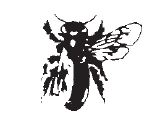
(3/4 - 1")
These bees burrow into wood, forming a series of linear galleries and chambers running along the grain of the wood. Their continuing tunneling activity in the same wood from year-to-year can weaken structural wood. Noisy, buzzing, dive-bombing males act aggressively but cannot sting. Carpenter bees have a shiny, nearly hairless abdomen.
NOTE: Fact Sheet EPP-7317 provides additional information about carpenter, honey, and other bee species.
Direct sprays or dusts of approved pyrethroids such as Suspend SC or DeltaDust around the entrance hole perimeter and into the entrance holes and galleries is effective. Then, 48 to 72 hours after treatment plug entrance holes with copper wool mesh, and seal the holes with plastic wood to improve the appearance of the damaged wood. Probing deep into the galleries with a stiff metal wire can kill developing bees. Remember, after an inch vertically into the wood the circular galleries make a right angle then run along the grain of the wood.
Insecticides (Outdoor). Cynoff EC and WP, Suspend SC, Demand CS, Demon EC, and DeltaDust have all been effective. Several other outside garden insecticides are marketed. Leaving the circular entrance holes open for 2 to 3 days after treatment before plugging increases bee exposure to insecticide.
CARPET BEETLES

(1/7 - 1/4")
Larvae feed on stored dry foods, non-synthetic natural-fiber rugs and rug padding, upholstery, clothes, stuffed toys, and furs. Adults primarily feed on pollen and do not damage household items and materials.
NOTE: Before applying any insecticide onto a carpet, read the product label carefully for warnings of potential discoloration and staining.
Thoroughly clean all carpets and rugs at regular intervals. Vacuum carpets and rugs before treatment (both sides when possible). Lightly treat infested carpets, rugs, and mats with insecticides. Dry clean furs, blankets, and other garments as necessary. Store susceptible furs, woolens, and clothing with naphthalene or paradichlorobenzene spheres, flakes or crystals inside air-tight containers. DO NOT breathe fumes.
Insecticides (Indoor). DeltaDust, Demand CS, Dragnet FT, Suspend SC, Ortho Home Defense MAX, Tempo SC Ultra and pyrethrin sprays are effective.
NOTE: Before applying any pesticide on a carpet, read the product label carefully for comments and warnings concerning potential staining and residues.
CLOTHES MOTHS
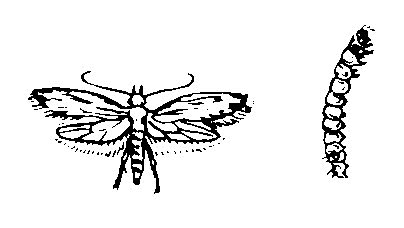
(1/2")
In the larval stage, these moths cause damage by feeding upon wool, mohair, fur, cotton, and other plant- and animal-based materials. Adults may fly out of a closet when you open the door.
Good housekeeping, sanitation, and thorough regular cleaning of garments help to reduce infestations.
Insecticides. DeltaDust applied to cracks and crevices in closets is useful. Larval stages feed upon wool, mohair, fur, silk, feathers, and non-synthetic garments and carpets, so these materials require treatment. Paradichlorobenzene crystals or naphthalene moth balls (usually 1 lb. of material per 100 ft3 of closet or container space; follow label) kills moths. For protection of stored garments and fabrics, use air-tight containers. Suspend SC, Tempo SC Ultra, and pyrethrin sprays used per label directions have been effective.
NOTE: Check labels for warnings of possible discoloration and staining to clothing. Treated areas should be air-tight. DO NOT breathe fumes. Dry-clean garments before placing into long-term storage.
POWDERPOST BEETLES

(1/5 - 1/4")
These beetles primarily feed on sapwood of U.S. hardwoods, and also attack tropical hardwoods and bamboo. Their presence is indicated by small ‘shot holes’ in the wood surface with piles of fine sawdust underneath, and winding round galleries in the wood packed with fine-to-coarse powdered sawdust.
For severe infestations with many exit ‘shot’ holes, employ a pest control company.
Insecticides and Wood Preservatives. Several products are labeled for indoor use (follow label directions). For new construction use kiln-dried lumber, or use preserved, pressure-treated wood for structural framing. Borate liquid applications to wood surfaces are beneficial. Demon TC, Suspend SC, Tempo SC Ultra and other insecticides are also available for surface applications. Replacing severely infested or damaged wood with preservative treated wood may be a viable alternative.
SILVERFISH; FIREBRATS
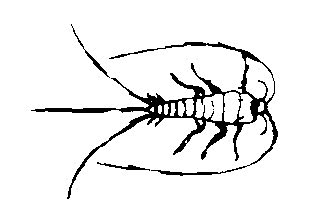
(3/4")
Silverfish feed upon most any vegetable food and glues with high starch, protein, and/or sugar content (e.g., book bindings, cereals, wallpaper, starched clothes and curtains, some glues and pastes, and bookbinding glues).
Treat floors of closets, storerooms, water tank closets basements, attics, cracks and crevices, moldings, pantries, book cases, and hot water closets. Also treat hiding places around and behind baseboards and window frames. Attics can also be treated with ‘foggers’ and dusts.
Insecticides (Indoor). DeltaDust, Demand CS, Demon EC, Dragnet FT, Ortho Home Defense MAX, and Suspend SC along with many additional insecticides are marketed. Niban Granular Bait and Silica gel powders are also effective. Frequently, the attic needs to be dusted with Drione dust or DeltaDust. A pest management professional has the dusting equipment required for an effective application.
TERMITES
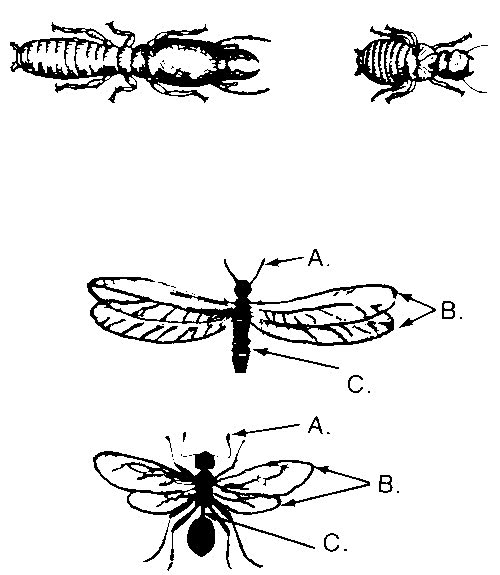
Soldier: (1/4 - 3/4"); Winged Termite: (3/4")
Frequently, the first sign of wood-damaging subterranean termites is the sudden appearance of swarming, winged reproductives. Long, narrow mud tubes can also appear on walls and building foundations. Workers forage out from the subterranean colony, constructing mud tubes through which they travel along foundation walls and wood boards to reach above ground wooden building components.
DIFFERENTIATING TERMITES FROM ANTS:
- Termite antennae are straight and look like a string of small, round beads. They are not elbowed or bent.
- Termite front and hind wings are nearly equal in size and shape.
- Termite swarmer (black or tan body) waistline is not constricted or pinched inward,
and is as wide as the thorax. Note these differences when comparing the winged termite
illustration with the winged ant illustration.
Liquid termiticide is applied to soil by trenching, or trenching and rodding, and by surface applications as noted on the label(s). Trench around the exterior and interior of foundation walls, piers, and stiff-legs. Also apply by drilling through concrete patios, walkways, garage floors, and other concrete slabs that are adjacent to foundations to form a continuous barrier to prevent termite movement from the soil into structural timbers. However, termite management experience and specialized equipment are required to make thorough treatments against termites. Therefore, it is recommended that a licensed pest control company be employed to treat a structure for termites.
Termiticides. Some termiticides that pest control companies currently use for treatments directly to soil, or for aboveground applications inside wall voids, include Premise, Termidor SC and HE, Cyper TC, Baseline Pre-Treat, Prevail FT, Permethtin TC, Demon TC, Tengard SFR, Times-Up, and MasterLine+C. Additionally, borate products like Tim-Bor and Bora-Care, Bor-Am, Board Defense, and several other borate-containing insecticides are increasing in use as supplemental liquid treatments to wood surfaces.
Baits. Baiting system termite control involves pest control companies installing bait stations, e.g., the Sentricon and Hex-Pro Systems, Exterra Bait System, Advance Bait System, or Smartdisk Firstline Baiting System.
III. Pests that Bite or Sting; Nuisance and Annoyance Pests
BED BUGS

(1/7 - 1/3")
Since the turn of the 21st century, bed bug encounters and infestations have significantly increased nationwide. Because bed bugs feed on blood of man and animals, often resulting is numerous skin welts and extreme itching that can lead to scratching and infection, they must be controlled. They feed mostly at night and can live for many months without taking a blood meal. This capability increases their persistence and pest status.
Spray bed springs, slats, and bed frames and cracks and crevices of woodwork, around doors and window casings. Dust behind base boards and electrical outlet wall plates. “Climb-Up® Insect Interceptor” capture and exclusion devices placed under bed legs, and mattress encasements as physical barriers are also helpful. Steam-treating mattress seams and tufts also kill eggs and adults. Wash all bedding materials in hot soapy water and dry on high heat.
Insecticides. DeltaDust, Demand CS, Drione dust, Suspend SC, Tempo SC Ultra, and Bayer Advanced Home Pest Control are a few of many currently marketed pesticides against bed bugs. Do not treat mattresses or other surfaces that will be in direct contact with people or pets. 'Green' products incorporating natural plant oils and other 'natural' compounds are not known to provide effective long-term control.
BOXELDER BUG; RED-SHOULDERED BUG
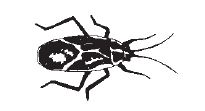
(1/2")
These occasional pests generally occur in the fall and spring. During the summer they are often found on maple, ash, boxelder, golden rain tree, and fruit trees. As cool fall weather approaches, they migrate into buildings to overwinter. They re-appear in the spring as the weather warms up. They do not attack people, pets, or clothing, but occasionally are found feeding on some house plants. They occur in large numbers and can be difficult to control.
Insecticides (Indoor). Vacuum up these invaders, and treat thresholds, window sills and exterior cracks and crevices with an insecticide labeled for these pests. These include Cynoff EC, DeltaDust, Demand CS, Demon EC, and Suspend SC plus many others. Also, caulk all external openings and cracks around door and window frames.
Insecticides (Outdoor). Tree trunks, house foundations, walks, patios, and under house eaves must be sprayed.
Treat ground cover, tree trunks, and
foundation walls starting when bugs are first seen (March-April, and September). Repeated
treatments directed at the clusters of bugs are usually needed for
continuing control. Removing female box elder trees and golden rain trees from close
proximity to the house will reduce bug habitat.
See Extension Fact Sheet EPP-7306.
CENTIPEDES; MILLIPEDES
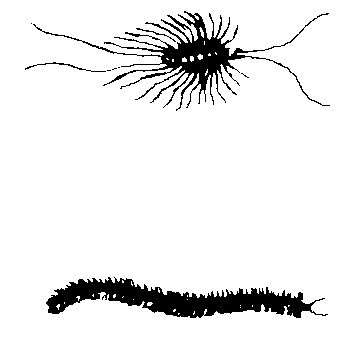
Centipede: (1/3"); Millipede: (1/2-2")
Centipedes feed on insects and many other arthropods. Millipedes feed on decaying vegetation, and roots and leaves of plants growing in damp soil. They can occur in large numbers and may infest ornamental plant and vegetable garden areas.
Pesticides (indoor). Inside, treat thresholds, baseboards, and cracks and crevices with ready-to-use sprays or dusts. Ortho's Total Flea Killer, Ortho's Flying Insect Killer, Or-tho Home and Garden Insect Killer, Ortho Flea-B-Gon Flea Killer, or DeltaDust are effective.
Pesticides (Outdoor). Spray potential entry sites and areas where pests are present. Demand CS, Demon EC, Dragnet SC, Suspend SC, Tempo SC, and Drione dust are some of many pesticides available. Remove excessive mulch, compost, and piles of wood or debris away from the home. See Fact Sheet EPP-7316 for additional information.
CONENOSE BUG (kissing bug; assassin bug)

(1/2")
Many species of true bugs can inflict painful bites with their sharp, needle like piecing mouth parts. One group (Triatominae) feeds exclusively on the blood of man and other animals. They feed at night. These large, occasional house invaders can be vacuumed up and the vacuum bag contents destroyed. Some of these bugs harbor diseases.
First, exclude these bugs from the home. All exterior doors should fit tightly and have bottom door-sweeps. Replace damaged weather stripping. Window screens, attic vents, and crawl space vent screening should be intact. Seal around all water faucet pipes, AC lines and wires exiting the house exterior walls. Caulk exterior wall cracks and crevices around the house. Treat the underside and springs of outdoor furniture with a properly labeled spray or aerosol, or employ a professional pest control operator. Demand CS, Demon EC, and Dragnet SC are some of many labeled pesticides for these bugs. Destroy trash piles and remove squirrel and other animal nests.
CRICKETS
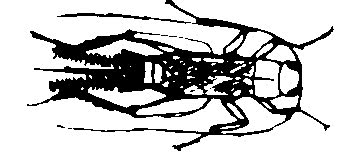
(1/2 - 1 3/4”)
Crickets are attracted to lights and often enter the home during the summer and early fall, especially if porch lights are illuminated. They chew on and destroy plants, eat holes in paper, rubber, and garments made of cotton, linen, wool, or fur, and are very mobile. Adult crickets occur in large numbers and can be difficult to control.
Treat doors, thresholds, baseboards, and cracks and crevices where crickets hide. Large, older crickets can be difficult to control. Control with exterior perimeter insecticide band and lawn treatments to keep crickets from entering home. Caulk and seal all exterior small openings and pest entry points into the structure, and turn off outside lights at night when crickets are present and creating a nuisance.
Insecticides (Outdoor). Bayer Advanced Home Pest Control, DeltaDust and DeltaGard Granules, Drione dust, Suspend SC, and Tempo SC Ultra are some of many available insecticides. Insect foggers can also be effective.
DRAIN FLIES (sewer fly; moth fly)
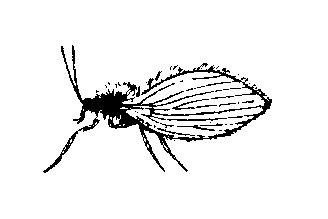
(1/16")
Drain flies are tiny, long-legged, often hairy, moth-like flies. Wings are usually held roof-like over the body. These flies frequently develop in the gelatinous material and gummy debris that builds-up inside drain pipes beneath sinks and in shower drains.
Clean out gelatinous build-up from drains and sinks and flush with boiling water to eliminate conditions conducive to breeding. Clog removing drain cleaners including chemical and microbial products applied down drains will help kill larvae and eliminate breeding sites. Remove garbage from inside daily.
Insecticides (Indoor). Aerosols and space sprays or aerosols containing Pyrethrins or Resmethrin, or pyrethroid sprays will help control adults.
FLEAS

(1/10”)
Fleas are often transported into the home on dogs, cats, rats, mice, and other animals. Flea larvae develop on organic matter, animal wastes and debris in the soil, as well as in animal bedding, rugs and carpets, sleeping blankets, and other areas frequented by pets. Before applying insecticide on a rug or carpet, read the product label carefully for comments on potential staining.
Pets need to be treated. It is best to consult a veterinarian regarding pesticides to use on pets, as some breeds are sensitive to systemic pesticides. Vacuum carpets thoroughly prior to any treatment, and dispose of the vacuum bags in a sealed garbage container. Spot-on, Precor applying an (Methoprene) and Petcor (pyrethrin + methoprene) animal applications and several other topical systemic treatments are available over-the-counter.
Applying Insecticides (Outdoor). Pyrethrins and DeltaDust may be used to treat lawns and dog kennels (outside only). Pyrethrins plus synergist can be used (see label). Suspend SC, Tempo SC Ultra, Advanced Outdoor Flea Spray, House and Kennel Aerosol Spray, and house and carpet sprays or bombs are effective. NOTE: For severe flea infestations in the home or yard it is suggested you employ a pest management professional.
HOUSE FLIES
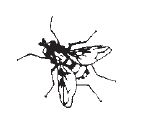
(1/10 - 1/4”)
House flies can carry or spread disease organisms from material on which they feed, walk, or breed, transferring disease organisms to feed and food. They often build up to large numbers within a short period, thus sanitation and regular garbage removal is one key to successfully eliminating flies.
Practice good sanitation within and outside around the home. Remove all food and organic debris materials to reduce fly habitat. For adults, aerosol bombs labeled for fly control are effective inside outbuildings. Fly paper, insecticidal hanging strips, and granular baits are useful in garages and barns. Treat garbage bins and trash collection locations. Remove or compost manure and organic waste.
Insecticides; sticky traps; fly paper (indoor). Almost all infestations can be controlled by improved sanitation.
Pyrethrin aerosol foggers and spays are helpful. Fly baits and sticky paper kill many
adults with little pesticide risk to home occupants. Adhere strictly to label directions.
MOSQUITOES (+gnats and midges)

(1/4 - 1/2”)
Only females bite. One blood meal is sufficient for her to produce many eggs. Immature stages of mosquitoes cannot develop without water in which to live and feed. Eliminating standing water outside structures will help reduce mosquito problems. They are prevalent spring, summer, and fall, as long as mild weather prevails. Unusually cold winters can reduce spring populations.
NOTE: See Extension Fact Sheet No. 7012 for additional information on mosquito control.
Insecticides (Outside). For adults, spray window screens, shrubs, ornamental plants, and around doors and windows. Use space sprays (aerosols) inside (pyrethroids) or sprays labeled for mosquito, gnat, or midge control. Cynoff EC, Demand CS, Ortho Flying Insect Killer, Ortho “Mosquito-B-Gon” Tree and Shrub spray, Demon EC, Suspend SC, Tempo SC Ultra, and several more although some of these are for commercial applicator use only.
For larvae, treat temporary rain pools, intermittently flooded areas, tree holes, and standing or stagnant water with a labeled larvacide. Drain or fill low-lying landscape areas where water collects, and empty and discard artificial containers such as old tires, buckets, cans, or other water-holding items. Standing water can be treated with Altosid per label as a liquid, pellets, or briquettes. Bacterial insecticide Bacillus thuringiensis variety israelensis (apply per label directions); Bayer Advanced Mosquito Preventer Granules; Mosquito Dunks (Bt. i.) and similar products are available for treating breeding sites.
SCORPIONS
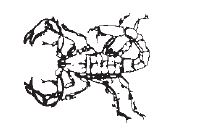
(1 1/2 - 3 1/2”)
Mostly active at night, scorpions hide during the day in sheltered areas under boxes and boards, leaf litter, under door mats, or within walls of buildings. Increase in scorpion activity is often noted when there is a change of weather. Scorpions found in Oklahoma are not considered dangerously venomous. However, if stung, you should consult a physician. NOTE: See Extension Fact Sheet EPP-7303 for additional information.
Pesticides (Outdoors). Clean up cluttered areas with accumulations of old lumber, boxes, rags, bricks, concrete pavers, and harborage areas. Outside apply band treatments around the foundation wall perimeter and out into the lawn (retreat according to label directions, usually every 10 to 14 days). If treatment is needed in a houses crawl space, it is advised to employ a pest control company. Scorpions can be difficult to control. Many pesticides are labeled for scorpions. Demand CS, Demon EC, Suspend SC, Tempo SC Ultra, and Drione dust are all useful.
Pesticides (Indoor). Clean up cluttered areas in closets, basements, attics, enclosed porches, and storage areas to remove hiding places. Treat baseboards, moldings, and cracks or crevices with a dust or liquid spray. Indoor-and outdoor-use pesticides are often the same, but indoor applications should use the lowest label rates to reduce exposure to occupants. Dust between floors and around possible harborages are useful.
NOTE: Clean up trash and debris under and around the house and in cluttered areas like attics, closets and basements. Inside living areas spray or dust around windows, behind baseboards and door frames, in closets, and near (not into) heat and air ducts, and under sinks, paying particular attention to cracks and crevices. Replace worn, ineffective door-sweeps. Caulk and seal all exterior entry points around doors and windows, and around pipe penetrations through brick facades and walls. Screen over weep holes drilled in grout between building facade bricks. Seal cracks and crevices, and ensure window screens are intact.
SPIDERS
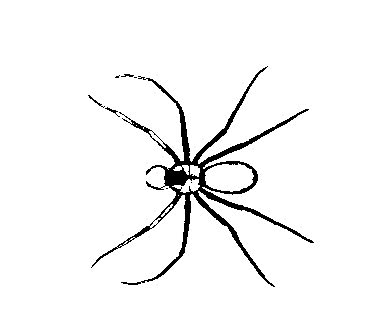
'Fiddleback'/ 'Violin' Spider (1/2 - 1 1/2”)
Black Widow, Brown Widow, and Brown Recluse spiders are the Oklahoma species with the most dangerous bites. However, bites from other much less venomous common spiders can affect small children and hypersensitive individuals, causing redness and swelling of the skin. Remember that spiders are mainly beneficial, doing more good than bad, in that they feed upon pest insects, but are also a ready food source for many birds, reptiles, arthropods, and mammals. Non dangerous spiders should not be indiscriminately killed.
NOTE: Brown Recluse (‘fiddleback’) spiders are difficult to control and often build-up to large numbers, especially in vacant homes and buildings. For severe infestations of this spider a homeowner should consider hiring a pest control company to treat the infestations (especially in attics, garages, and crawl spaces, as well as closets, storage areas, and living areas).
Remove debris and clean out cluttered areas inside and around the outside of home. Also, clean out attics, basements and closets. Brown recluse spiders especially like to hide under and behind baseboards and in any other harborages. Treat cracks and crevices of baseboards, moldings, and under sinks and all potential hiding areas. Extensive use of mouse sticky boards placed flat on the floor in room corners and under dressers next to walls will capture and kill many spiders. Insecticide band treatments with sprays and dusts around the outside foundation wall perimeter and out into the lawn will help keep spiders from wandering into the home.
Pesticides. Cynoff EC, DeltaDust, DeltaGard granules, Drione dust, and Suspend SC are a few of the many pesticides labeled for use against spiders. Dusts are often more effective than liquid sprays.
Caulk and seal all exterior entry points around door and window and pipe penetrations through brick facades and walls. Screen over weep holes drilled in grout between building facade bricks. Replace worn, ineffective door-sweeps.
TICKS
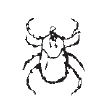
(1/2 - 1 3/4”)
Treat pet bedding and sleeping areas, and replace old bedding with clean, but non insecticide-treated bedding.
NOTE: “Seed Tick” is a term for the recently hatched six-legged larval stage of tick development. Refer to Extension Fact Sheet EPP-7001 for specific information on ticks.
Dogs and cats often need to be treated, usually with a topical (some systemic) insecticide. It is recommended to consult a veterinarian to purchase a material labeled for tick control on animals. Also, you may need to treat the yard and surrounding planter areas and animal resting areas with an insecticide. For severe infestations, you may wish to hire a pest management professional for both inside and outside tick control.
Insecticides (Indoor) Aerosols foggers and sprays containing IGRs, or ready-to-use sprays can be applied to base-boards and other cracks and crevices, are effective for control of brown dog ticks.
Insecticides (Outdoor). Cynoff EC, DeltaDust, Demon EC, Demand CS, Drione dust, and Suspend SC are some of many insecticides marketed for outside applications. Broadcast applications over lawns and ornamental areas may be needed (follow label directions).
WASPS; HORNETS; YELLOW JACKETS
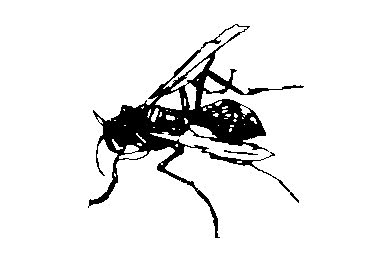
(1/2 - 1 3/4”)
Paper wasps, hornets, and yellow jackets emerge during the first warm days of spring and build their single comb, paper-like nests under house eaves and porches, or in sheltered areas such as sheds, barns, or garages, or within in-ground cavities (yellow jackets).
NOTE: Researchers have reported that insect repellents have not been proven effective against paper wasps. Commercial yellow jacket traps may be helpful when put in place before picnics or outdoor activities occur. See Extension Fact Sheet EPP-7305 for further information.
Apply insecticide directly to nest and resting locations, possibly at night. Remove nests when no activity is observed. For underground nests like yellow jackets, apply insecticide directly into the entrance hole and close over immediately with soil.
Insecticides (Outdoor). Ready-to-use sprays and aerosols that are labeled for wasps and hornets and their relatives are marketed for inside buildings as well as outdoors. The aerosols labeled as ‘wasp freeze’ or ‘jet spray’ work well. Demand CS, Tempo SC Ultra, and Demon EC sprays, plus DeltaDust and Drione dust can be applied to the nests. These pests are generally controlled outside, only occasionally invading inside living areas. Fact Sheet EPP 7305 provides additional information.
NOTE: Some municipalities in Oklahoma regularly detect insecticides in their treatment plant waste water that originates as influx from sanitary sewers. This contamination is due to improper disposal of unwanted pesticides by the general public into sink drains and toilets, and can occur in any community nationwide. Never pour any pesticide into a household drain, storm water sewer, drainage ditch or any other water drainage apparatus or area. Proper disposal is important to protecting you and the environment from harmful contamination. The OSU Pesticide Safety Education Program coordinates an annual no-cost pesticide waste disposal drop-off and collection program. Check the website, www.pested.okstate.edu, and click on “Unwanted Pesticide Disposal Program” for scheduling and locations. Overall, safe and effective use of pesticides is the overriding objective.
The pesticide information presented in this publication was current with federal and state regulations at the time of printing. The user is responsible for determining that the intended use is consistent with the label of the product being used. Use pesticides safely. Read and follow label directions. The information given herein is for educational purposes only. Reference to commercial products or trade names is made with the understanding that no discrimination is intended and no endorsement by the Cooperative Extension Service is implied.
Brad Kard
Professor
Structural/Urban Entomology
Russ Wright
Professor Emeritus/Entomology
Kevin Shelton
Extension Pesticide Coordinator
Charles Luper
Extension Associate
